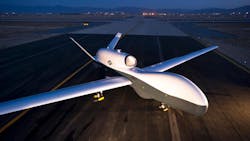Northrop Grumman to outfit Navy MQ-4C Triton unmanned aircraft for SIGINT missions in $33.8 million order
PATUXENT RIVER NAS, Md. – Signals intelligence (SIGINT) experts at Northrop Grumman Corp. will upgrade the U.S. Navy MQ-4C Triton long-range unmanned aerial vehicle (UAV) with SIGINT capability to match that of the Navy's EP-3 manned SIGINT aircraft under terms of a $33.8 million order announced Monday.
Officials of the Naval Air Systems Command at Patuxent River Naval Air Station, Md., are asking the Northrop Grumman Aerospace Systems segment in San Diego carry out the Triton integrated functional capability (IFC) 4.0.
The MQ-4C Triton, built by Northrop Grumman Aerospace, is a maritime patrol version of the Northrop Grumman RQ-4 Global Hawk long-range reconnaissance UAV. The Triton provides real-time intelligence, surveillance, and reconnaissance missions (ISR) over vast ocean and coastal regions.
The Triton IFC 4.0 project seeks to upgrade the Triton UAV with multi-intelligence capabilities that include SIGINT, such that Triton IFC 4.0 UAVs could replace the Navy's fleet of EP-3 aircraft.
The EP-3 aircraft are based on the Lockheed Martin P-3 Orion four-engine turboprop airframe, and are scheduled to be retired in 2021. Much of the EP-3's mission and electronic equipment is secret and is conducted in high-threat areas where long-range standoff is necessary.
Related: Triton maritime surveillance UAV technology upgrades: Navy's just getting started
The Triton integrated functional capability (IFC) 4.0 program is installing a SIGINT sensor payload with components from Boeing Argon ST in Fairfax, Va., and Sierra Nevada Corp. in Sparks, Nev. Navy plans call for delivering the IFC 4 version of the Triton UAV in 2021 to coincide with the Navy’s retirement of the EP-3.
This order procures material kits and retrofit labor to incorporate the IFC 4.0 configuration into retrofit Triton aircraft and ground segments. Previously Northrop Grumman carried out Triton IFC 3.0 upgrades to add sensor enhancements, Link-16 capability, and interoperability functionality to the Triton.
On this week's order Northrop Grumman will do the work in San Diego, Palmdale, Irvine, and San Clemente, Calif.; Waco, Texas; Salt Lake City; Newtown, N.D.; Verona, Wis.; Sterling, Va.; and at other locations, and should be finished by January 2022.
For more information contact Northrop Grumman Aerospace Systems online at www.northropgrumman.com, or Naval Air Systems Command at www.navair.navy.mil.

John Keller | Editor-in-Chief
John Keller is the Editor-in-Chief, Military & Aerospace Electronics Magazine--provides extensive coverage and analysis of enabling electronics and optoelectronic technologies in military, space and commercial aviation applications. John has been a member of the Military & Aerospace Electronics staff since 1989 and chief editor since 1995.

